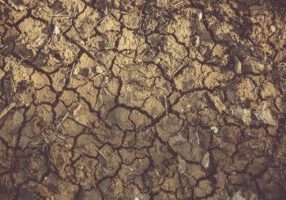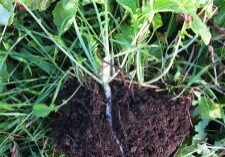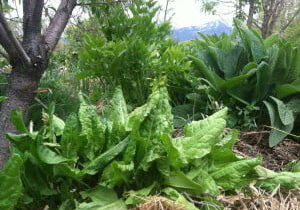The problem: Heavy clay soil is easily compacted creating a barrier to the movement of roots, water and oxygen in the soil. Heavy soil drains very slowly which can create water logging and rot, even in dry areas. On the positive side the cation exchange capacity (CEC) of many clay soils is very high, so in the long term they can be built up to hold nutrients and be more productive.
I get a very high survival rate with bare root seedlings, but it takes some attention. This technique is also effective for potted trees or root balls.
 These are the steps I use for planting trees in heavy clay soil:
These are the steps I use for planting trees in heavy clay soil:
- Dig a square hole with long sloping sides.
- The saucer shape forces the roots toward the surface for more oxygen and nutrients while the square or jagged corners can help the roots stop circling and push out of the hole.
- Round holes, especially in heavy clay can encourage root bind.
- If you stick in a shovel and the sides look ‘glazed’ or smooth you are at risk of creating a solid clay pot that the plant will have difficulty escaping.
- A fence post auger is not great for heavy clay. I have seen entire auger-planted orchards die 8 years later from root bind. If you use a post auger, go back after and re-dig the hole by hand.
- Check percolation rate.
- Before you plant, fill with water to check the drainage, if the drainage is very slow, pay close attention to how you water through the season as it will be very easy to over-water and drown the the tree. They will need regular water every 3-5 days, but not over watering. I usually give them 1-2 gallons of water every 3 days.
- Check the root to top ratio.
- Prune the top to match the roots. You can even over-prune the tops slightly to take stress off of the roots.
- Bare root or potted trees that have been left tall will have roots that are cut back to fit the pot. If the root to top ratio is off, the top will pull too much energy from the roots and can kill the tree or go into transplant shock.
- Don’t expose the bare roots to sun for more than 30 seconds.
- The microscopic root hairs are probably already damaged and sun will quickly kill whatever of them remain.
- Make sure your planting depth is correct, not too deep or above ‘grade’.
- Locate the crown of the plant and align that with the soil surface. Sometimes it is good to account for a small amount of settling by planting a little bit high.
- Get the roots back into the three dimensional shape they were in when they were uprooted.
- I screen the soil to a very fine texture and if it is pure clay, I sometimes add a small bit of sand or coconut coir. Don’t bend the roots to fit the hole, it is better to make the hole bigger or prune the roots.
- Backfill is important.
- Make sure the back-fill soil is fine, no clods, rocks, twigs etc.
- All of the spaces in the root need to be filled. Air gaps will kill sections of root.
- Don’t fill the hole with compost and fertilizers.
- Roots tend to avoid texture and nutrient ‘differentials’ and will stay where things are easy. A heavily amended hole with compost or other fertilizers, can create a ‘lazy’ tree that doesn’t try and get out of the hole. It may eventually root bind. You can use a very small amount of compost to inoculate the soil with bacteria and a multi-strain mycorrhizal inoculate can also help. Dipping the roots in a light kelp solution helps them recover from transplant shock and re-grow root hairs.
- Note: There are some planting techniques that encourage deep holes and large amounts of compost and other amendments in the hole. I can’t speak directly to those methods, but can see cases where planting a few trees in that way would be successful, especially for less hardy tree types. However, for bulk planting of many trees, the time and material expense seems too high.
- Roots tend to avoid texture and nutrient ‘differentials’ and will stay where things are easy. A heavily amended hole with compost or other fertilizers, can create a ‘lazy’ tree that doesn’t try and get out of the hole. It may eventually root bind. You can use a very small amount of compost to inoculate the soil with bacteria and a multi-strain mycorrhizal inoculate can also help. Dipping the roots in a light kelp solution helps them recover from transplant shock and re-grow root hairs.
- Amend at the soil surface with compost and mulch.
- Perennials are mostly adapted to top-down feeding, so creating fertility at the soil surface will encourage natural development.
- Extra-deep mulching is great if drip irrigation will be applied under. However if the mulch is too deep in a dry environment it will stop small rain events from getting to the ground.










Thanks, Aaron. This article was very interesting and “made sense” to me. I live in Northern Utah in Cache County where the soil is very clay. I’m ‘putting in a yard’ but am not an experienced gardener so have been researching ideas for planting trees in clay soil. Of course, my trees are not bare roots but generally come in a pot or a burlap bag. I’ve also been going for larger trees which complicates things. I just tried this method with several ornamental pear trees and I really liked how it “felt.” Like I said above, it just made sense to me.
I do have a question: I’ve got a 10 foot Alaskan Red Cedar I planted recently in the same heavy clay soil. By and large, it looks like it’s doing okay but there is a bit of yellowing here and there. It doesn’t appear to be getting worse but it’s kind of hard to tell with the heavy foliage on a weeping cultivar. The guy who planted it didn’t do any real amendments to the soil. He just dug a hole, removed the top of the burlap, and covered up the root ball. The soil does tend to drain pretty well but can you give me any advice other than just “lots of water and leave it alone”? Thanks!
Hi John,
Thanks. Glad it is helpful.
I have a red cedar I’m trying out as well and it is also showing some yellowing at the ends of the branches. Possibly the soil is too alkaline, some nutrients are locked up or particular symbiotic bacteria or fungi aren’t present in the soil. I would add a lot of compost and worm castings at the surface, 2-6 inches deep, and out in a circle with a diameter as wide as the tree is tall and then mulch over the top of that with wood chips. You would also try lowering the pH slightly with ascorbic acid. It sounds like your soil is draining well enough, but overwatering in heavy clay can also cause waterlogging and deprive trees of oxygen.
can one use gypsum to improve heavy clay soils for tree transplants?
It depends on the type of clay soil. Sodic soils may benefit from gypsum (calcium sulfate). The gypsum displaces sodium in the soil, improving particle aggregation and allowing the sodium to be flushed out over time. A soil test is mandatory. In non-sodic heavy clay like my soils which are already extremely high in calcium and sulfate, applying gypsum would just lead to nutrient imbalance.
A couple of amendments that I do find helpful are a wetting agent like Therm x-70 (yucca saponins) to improve water pentation in clay. Also, Fulvic acid helps with nutrient uptake and causes micro-aggregation in heavy clay so that water can move more readily and aeration is improved.
I have also read studies about using hydrogen peroxide to help oxygenate clay soils and break glazing, but have not tried them myself.